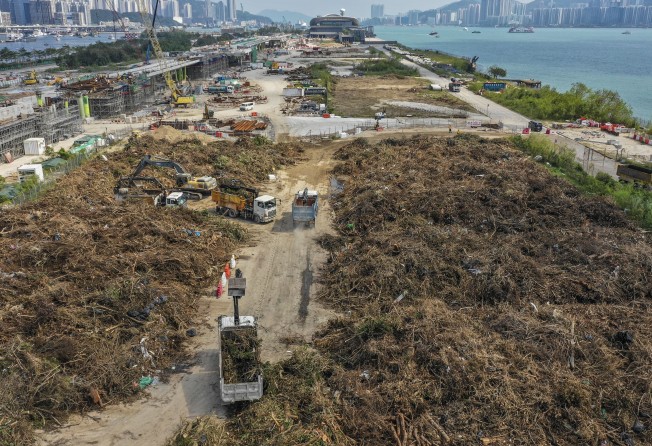Most of the trees felled in Hong Kong by Typhoon Mangkhut to go straight to landfill
- Collection point on site of old airport to close

Most of the trees felled when Typhoon Mangkhut hit Hong Kong will go straight to landfill, starting this Sunday.
Officials announced the plan on Thursday, as the collection site at Kai Tak for tree waste was about to close.
The Environmental Protection Department (EPD) also announced a new attempt to reuse tree waste by making its newly bought industrial-grade wood shredder available for public use. It will be placed near T.PARK, the city’s first sludge treatment facility, next to the department’s Tuen Mun landfill site.
The soon-to-close collection area, on the site of the old Kai Tak airport, opened on September 21, five days after monster typhoon Mangkhut ripped through the city, causing floods and travel chaos, as well as felling at least 55,000 trees.
It would stop receiving tree waste at 6pm on November 10, the department’s spokesman said. That was because the amount of incoming waste was dwindling and the sites were earmarked for construction.
“Since early November, the EPD has started to close the collection area in phases to facilitate the handling of the remaining tree waste there,” the spokesman said, adding that government departments and contractors were already taking collected tree waste directly to landfills.
The EPD said about 8,000 truckloads of tree waste had been delivered to the collection area since it opened and more than 15,000 tonnes of it had been cleared from the site by Thursday. It said the Kai Tak area could be cleared by the end of this month.

The department planned to use the tree waste that would be chipped by its wood shredder as far as possible to conduct various treatment trials, including using it as a bulking agent in compost, turning the shredded wood and wood pellets into solid fuel for boilers or cement manufacturing, or turning it into soil cover at landfill sites. It also pointed out that some of the shredded wood would always have had to be sent to landfill, because of the limited channels for recycling.
Veteran tree expert Professor Jim Chi-yung said using the shredded wood as fuel was a good idea.
“In some places, wood chips can be used as fuel for power plants,” Jim said. “But, somehow, Hong Kong’s power plants don’t seem to be equipped to do this.”
He said using wood chips for composting would not work, as the chips would lock up the nutrients from other materials, lowering the quality of the compost.
Tree experts and green groups earlier criticised the government for failing to handle the wood properly, saying it could have been reused. They raised concerns over a lack of policy and hardware planning on yard waste. Environmentalists proposed measures such as sorting the trees, chipping the wood, and composting.
Last week, the Post reported a tree waste recycler’s proposal to chip 250 to 280 tonnes of the wood daily at Kai Tak and sell it as biomass. But the department rejected that idea because the site needed to be vacated.
Jim said the government could consider giving proper sweeteners, such as low rent, to help companies deal with the tree waste.
“I believe the government and the public will support such economic activities,” he said.